The US island with no cars and one horse for every person
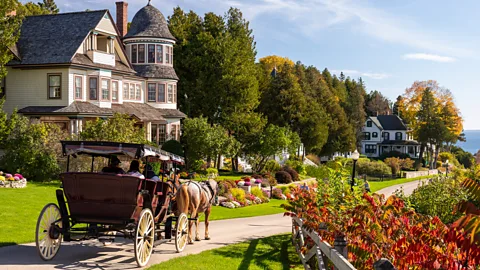 Mackinac Island Tourism Bureau
Mackinac Island Tourism BureauIn the midst of "the car capital of the world", there's a serene vehicle-free island home to 600 people, 600 horses and a once-upon-a-time way of life.
Home to the "Motor City" of Detroit, where companies like Ford, General Motors and Chrysler originated, the US state of Michigan is often called "the car capital of the world". But off the state's northern coast in Lake Huron is a serene, scenic island that has been luring travellers for hundreds of years – and has banned cars pretty much since they were invented.
Welcome to Mackinac Island: a 3.8-sq-km island home to 600 year-round residents, no motorised vehicles and the only US highway where you're not allowed to drive a car. Even golf carts are prohibited on the island's streets, so chances are if you hear a honk or a screech, it's from one of the island's geese or owls.
But why the absence of autos?
Because as Urvana Tracey Morse, who owns a craft store on the island's main drag, says: "Horse is king here."
 Getty Images
Getty ImagesAccording to local lore, when a car backfired in 1898, scaring horses nearby, village authorities banned internal combustion engines, a move that was extended to the rest of the island two years later. Ever since, locals have leaned into this tranquil, once-upon-a-time way of life.
More than a century later, some 600 horses keep things running here, from the depths of winter to the mad summer rush when roughly 1.2 million people board a 20-minute ferry from Mackinaw City or St Ignace on Michigan's Upper Peninsula and descend on the small village (also called Mackinac Island) on the island's southern tip. There, visitors shop for the village's famous fudge, explore its 70 miles of trails and soak up the clip-clopping sounds of a simpler time.
Rediscovering America
Rediscovering America is a BBC Travel series that tells the inspiring stories of forgotten, overlooked or misunderstood aspects of the US, flipping the script on familiar history, cultures and communities.
"Horses are used in everything from garbage removal to FedEx deliveries," says Morse, who has been selling scrimshaw, art, jewellery and other merchandise after first visiting as a college student in 1990. "That's how our lifestyle has been; that's how our pace is."
"Part of us just like the tradition that we get around by bike, or we walk or take the horse taxi," Morse adds.
For hundreds of years, Indigenous communities used the island's strategic location at the confluence of Lake Huron and Lake Michigan as a fishing and hunting ground. They thought its limestone bluffs and green forests resembled a giant turtle rising from the water, so they named it Michilimackinac, or "place of the great turtle" in Anishinaabemowin.
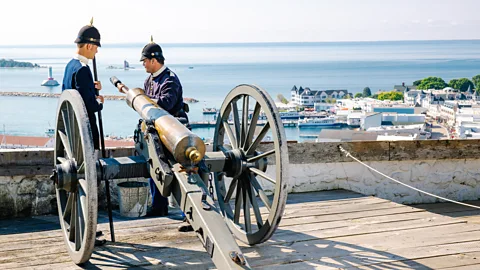 Mackinac Island Tourism Board
Mackinac Island Tourism BoardBritish forces shortened the name and established a defensive fort on the island in 1780. Today, visitors can still follow costumed interpreters, experience cannon firings and see an officer's quarters inside the oldest building in Michigan. But more than 200 years after the US took control of Mackinac following the War of 1812, its Indigenous roots remain.
Saddle Up
Visitors keen on getting in on the action can rent their own horse or horse-drawn buggy to explore the island, upon taking a short lesson.
"Mackinac Island is one of the most important [and] prominent places in Anishnaabe history and culture," says Eric Hemenway, an Anishnaabe member who has been instrumental in reviving Indigenous history on the island. "The Anishnaabeek people have been at the Straits [the waterways connecting Lake Huron and Lake Michigan], some say, since time immemorial. And we are still at the place of our ancestors here at the Straits. The waters were, and continue to be, the highways of the Midwest."
As Hemenway points out, a large number of Indigenous burial sites have been found on the island – some of which go back roughly 3,000 years. "[Mackinac] is one of our most sacred spots on the Great Lakes," he says.
Hemenway has also worked on the development of the Biddle House, which is home to the Mackinac Island Native American Museum that opened in 2021.
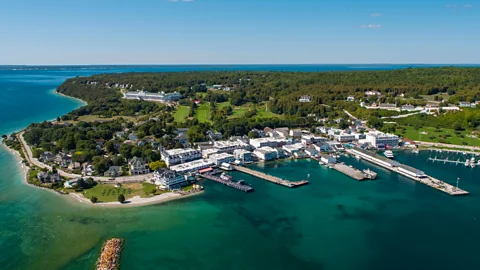 Mackinac Island Tourism Board
Mackinac Island Tourism Board"My biggest success [metric] is when I see other Native people come through… this is our story," says Hemenway. "[The island has] a touristy perception now, but the layers to this place are there."
By the late 19th Century, Mackinac Island had become a playground for wealthy industrialist families from Chicago, Detroit and other parts of the once-thriving Midwest, who flocked to the island in summer to unwind in its pristine waters.
More like this:
• The only land disputed between the US and Canada
• The US island that speaks Elizabethan English
• Dearborn, Michigan: A visit to the first Arab-majority city in the US
Mackinac's 138-year-old Grand Hotel has individually decorated rooms and claims to have the world's longest porch; it's also one of the last fully functioning hotels from industrial America's Gilded Age. Such is the Grand Hotel's unique appeal that Michigan governor Gretchen Whitmer recently took to X to pitch the island as the location for season four of HBO's The White Lotus.
While the pitch was playful, Morse is hesitant for Mackinac to become overtouristed. "You're proud of where you live; but at the same time I kind of don't want to tell people how cool it is here," she says.
 Getty Images
Getty ImagesIndeed, this pint-sized island packs a punch. Eighty percent of Mackinac's land area is comprised of Mackinac Island State Park, where visitors can stroll through old-growth forest, admire towering limestone pillars, and hike, bike or hire a horse-drawn carriage to photograph one of the island's most famous attractions – the 50ft-wide Arch Rock.
Elsewhere, locals suggest heading north from the island's one village to ramble the 8.5-mile highway turned bike-and-hiking trail that runs the circumference of the island and offers views of the five-mile-long Mackinac suspension bridge and access to quiet pebble-covered beaches and woodlands.
Horses aside, the island's 1,500 bikes for hire are the main way residents and visitors get around – a self-propelled mode of transport that suggests Mackinac residents are happy to move at a different pace than the rest of the country.
Living in a place without cars is one of the main reasons why Morse, who rides her bike nine months of the year, has decided to live year-round on the island, despite the harsh winters.
"I just love the idea of getting on my bike and coming down [to the village] through the trees. It sets me for the day," she says. "You are always greeting and talking to people."
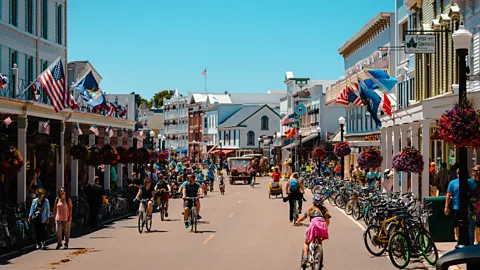 Getty Images
Getty ImagesBut while cycling is the easiest and most popular mode of transport, bikes clearly play a secondary role in powering the island.
"Without the horses, this place wouldn't be what it is. It's what makes you feel like you've stepped back in time when you get off the boat and you hear that 'clip-clop'," says Hunter Hoaglund, who works at Arnold Freight, a company that has run a ferry service to the island for 140 years and ships in a herd of its horses that overwinter on Michigan's Upper Peninsula every April. "We have our trucks show up here each day [dropping off the horses], and within the next month we'll probably see 200 to 300 more show up." An estimated 20-30 horses remain on the island during the winter to collect garbage, deliver packages and otherwise keep the island running.
Surrounded by crystal-clear water, Mackinac can be periodically cut off from the mainland in winter when ice floes can halt ferry services to or from the island.
But in spring and summer, Mackinac comes alive.
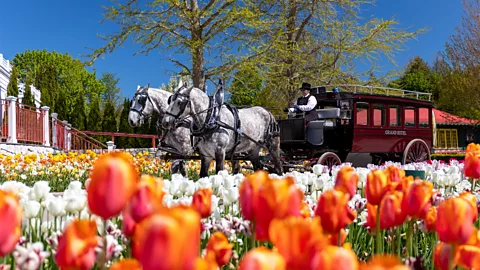 Mackinac Island Tourism Bureau
Mackinac Island Tourism BureauThe dozens of lilac trees dotted along the village streets start to bloom in the lead up to the island's popular 10-day Lilac Festival in June. Stargazers head to Mackinac's Fort Holmes – the highest point on the island – and the Grand Hotel's Cupola Bar for unfiltered views of the northern Michigan night sky. But for most visitors, happily tuckered out after biking around the island, an ice cream or piece of fudge is best enjoyed overlooking the marina.
And all without the sound of a car engine to spoil the experience.
--
If you liked this story, sign up for The Essential List newsletter – a handpicked selection of features, videos and can't-miss news, delivered to your inbox twice a week.
